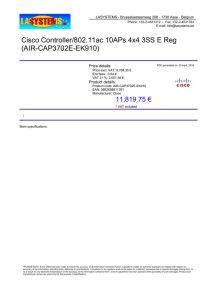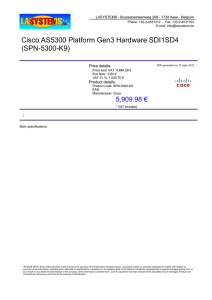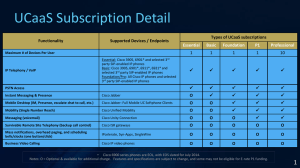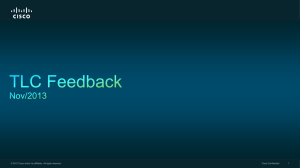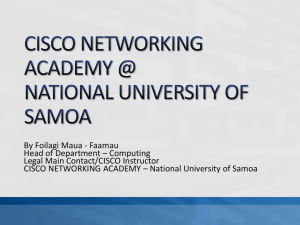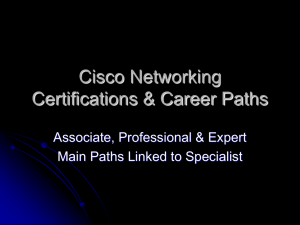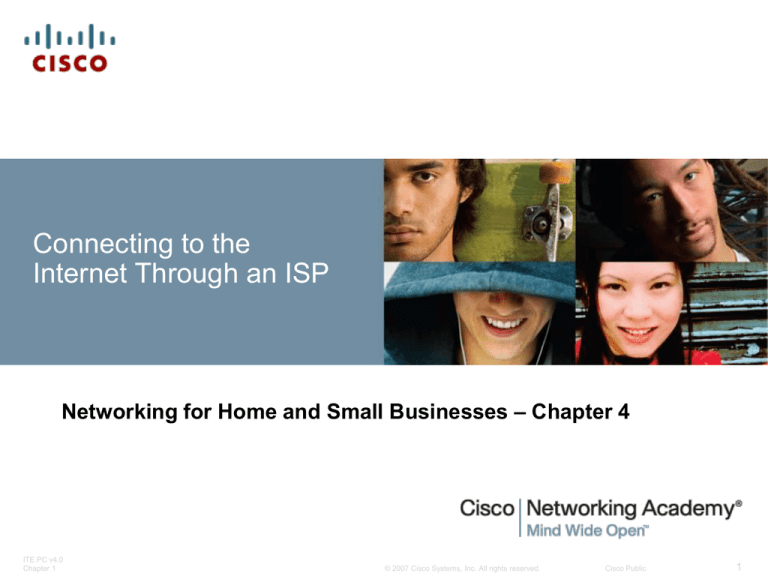
Connecting to the
Internet Through an ISP
Networking for Home and Small Businesses – Chapter 4
ITE PC v4.0
Chapter 1
© 2007 Cisco Systems, Inc. All rights reserved.
Cisco Public
1
Objectives
Explain “what is the Internet?” and how we connect to
the Internet using an Internet Service Provider (ISP).
Explain how information is sent across the Internet
through an ISP.
Describe and identify the components of an ISP
Network Operations Center.
Identify the different types of cables and connectors
for connecting the devices in a Network Operations
Center.
Construct and terminate twisted pair cables and
determine type of cable needed
ITE PC v4.0
Chapter 1
© 2007 Cisco Systems, Inc. All rights reserved.
Cisco Public
2
4.1.1 Explain What the Internet Is
The Internet is a network of networks that connects
users in every country in the world.
Users are connected to ISPs
ISPs are connected to other ISPs
ITE PC v4.0
Chapter 1
© 2007 Cisco Systems, Inc. All rights reserved.
Cisco Public
3
4.1.2 Internet Service Providers (ISPs)
Internet Service Providers
Give users access to internet resources
Allow organizations and individuals to publish information on the internet
ITE PC v4.0
Chapter 1
© 2007 Cisco Systems, Inc. All rights reserved.
Cisco Public
4
4.1.3 The ISPs Relationship With the Internet
ISPs use a POP to provide service to end users
There are many POPs in an ISPs network
ITE PC v4.0
Chapter 1
© 2007 Cisco Systems, Inc. All rights reserved.
Cisco Public
5
4.1.4 Options for Connecting to the ISP
Identify and describe the different connection options
that ISPs can provide
ITE PC v4.0
Chapter 1
© 2007 Cisco Systems, Inc. All rights reserved.
Cisco Public
6
4.1.4 Options for Connecting to the ISP
Dialup (56 Kb Modem)
Cable
Digital Subscriber Line
Leased Line (T-1)
Satellite
Cell Modem (Air Card)
ITE PC v4.0
Chapter 1
© 2007 Cisco Systems, Inc. All rights reserved.
Cisco Public
7
4.1.5 ISP Levels of Services
Various services are available
(see graphic)
Most ISPs offer two different
contract levels: home service
or business class service.
Asymmetric
Different upload and download
speeds
Used for home
Symmetric
Same upload and download
speeds
Used for business
ITE PC v4.0
Chapter 1
© 2007 Cisco Systems, Inc. All rights reserved.
Cisco Public
8
4.2.1 Importance of the Internet Protocol (IP)
Must run Internet Protocol (IP) software to
communicate on Internet
IP protocol is one of the TCP/IP (Transmission
Control Protocol / Internet Protocol) Protocols
As Ethernet uses Frames, IP uses Packets
Each IP packet must contain a valid source and
destination IP address.
ITE PC v4.0
Chapter 1
© 2007 Cisco Systems, Inc. All rights reserved.
Cisco Public
9
4.2.1 Importance of the Internet Protocol (IP)
The IP Packet (datagram)
• Has a header which
contains the source
and destination IP
addresses
• IP addresses must be
unique on the
Internet.
• Computers in homes,
small businesses and
other organizations
obtain their IP
configuration from
their ISP.
ITE PC v4.0
Chapter 1
© 2007 Cisco Systems, Inc. All rights reserved.
Cisco Public
10
4.2.2 How ISPs Handle Packets
Messages are divided into packets – size between 64 to 1500 bytes for
Ethernet
Downloading a single 1 MB song would require over 600 packets of 1500
bytes.
Each individual packet must have a source and destination IP address.
Packets or datagrams contain IP address and control information
IP addresses are granted to ISPs from a regional Internet registry (RIR)
RIR North America: ARIN (http://www.arin.net)
Internet Assigned Numbers Authority: responsible for IP addressing
Internet Corporation for Assigned Names and Numbers: responsible for
names and IP addressing
ITE PC v4.0
Chapter 1
© 2007 Cisco Systems, Inc. All rights reserved.
Cisco Public
11
4.2.2 How ISPs Handle Packets
NOC controls the flow of traffic
Sends traffic to remote networks if necessary
Contains services: e-mail, web
ITE PC v4.0
Chapter 1
© 2007 Cisco Systems, Inc. All rights reserved.
Cisco Public
12
4.2.3 Forwarding Packets Across the Internet
ping - tests end-to-end connectivity between source and destination
traceroute - traces the route from source to destination, displays each
router and 3 Round Trip Times (RTT)
Packets are sent from router to router until they reach their destination
PACKET TRACER 4.2.3.2
ITE PC v4.0
Chapter 1
© 2007 Cisco Systems, Inc. All rights reserved.
Cisco Public
13
4.3.1 Internet Cloud
ITE PC v4.0
Chapter 1
© 2007 Cisco Systems, Inc. All rights reserved.
Cisco Public
14
4.3.2 Devices in Internet Cloud
DSL Access Multiplexer (DSLAM)
Cable Modem Termination System (CMTS)
ITE PC v4.0
Chapter 1
© 2007 Cisco Systems, Inc. All rights reserved.
Cisco Public
15
ITE PC v4.0
Chapter 1
© 2007 Cisco Systems, Inc. All rights reserved.
Cisco Public
16
ITE PC v4.0
Chapter 1
© 2007 Cisco Systems, Inc. All rights reserved.
Cisco Public
17
4.3.3 Physical and Environmental Requirements
Physical requirements of a home network
versus an ISP
ITE PC v4.0
Chapter 1
© 2007 Cisco Systems, Inc. All rights reserved.
Cisco Public
18
4.4.1 Common Network Cables
Twisted Pair is used for Ethernet
ITE PC v4.0
Chapter 1
© 2007 Cisco Systems, Inc. All rights reserved.
Cisco Public
19
ITE PC v4.0
Chapter 1
© 2007 Cisco Systems, Inc. All rights reserved.
Cisco Public
20
Unshielded twisted pair (UTP) is the most commonly
encountered type of network cable in North America to
connect hosts, workstations, and other networking devices
ITE PC v4.0
Chapter 1
© 2007 Cisco Systems, Inc. All rights reserved.
Cisco Public
21
4.4.3 Coaxial Cable
Provides improved shielding compared to UTP, so has a lower
signal-to-noise ratio
More difficult to install
ITE PC v4.0
Chapter 1
© 2007 Cisco Systems, Inc. All rights reserved.
Cisco Public
22
4.4.4 Fiber Optic Cables
Provides improved shielding compared to UTP, so has a lower signal-to-noise ratio and
can therefore carry more data
Used in enterprise environments and large data centers
ITE PC v4.0
Chapter 1
© 2007 Cisco Systems, Inc. All rights reserved.
Cisco Public
23
4.5.1 Cabling Standards
ITE PC v4.0
Chapter 1
© 2007 Cisco Systems, Inc. All rights reserved.
Cisco Public
24
4.5.2 UTP Cables
Identify and describe the cross-over and straight through cable pinouts
and color codes
ITE PC v4.0
Chapter 1
© 2007 Cisco Systems, Inc. All rights reserved.
Cisco Public
25
4.5.2 UTP Cables
Identify and describe the cross-over and straight through cable pinouts
and color codes
ITE PC v4.0
Chapter 1
© 2007 Cisco Systems, Inc. All rights reserved.
Cisco Public
26
4.5.2 UTP Cables
Identify and describe the cross-over and straight through cable pinouts
and color codes
ITE PC v4.0
Chapter 1
© 2007 Cisco Systems, Inc. All rights reserved.
Cisco Public
27
4.5.3 UTP Cable Termination
Lab 4.5.3.2 – Building
Straight-Through and
Crossover UTP
Cables
ITE PC v4.0
Chapter 1
© 2007 Cisco Systems, Inc. All rights reserved.
Cisco Public
28
4.5.4 Terminating UTP at Patch Panels and
Wall Jacks
ITE PC v4.0
Chapter 1
© 2007 Cisco Systems, Inc. All rights reserved.
Cisco Public
29
4.5.5 Cable Testing
ITE PC v4.0
Chapter 1
© 2007 Cisco Systems, Inc. All rights reserved.
Cisco Public
30
4.5.5 Cable Testing
ITE PC v4.0
Chapter 1
© 2007 Cisco Systems, Inc. All rights reserved.
Cisco Public
31
4.5.5 Cable Testing
Attenuation - commonly referred to as insertion loss, is
a general term that refers to the reduction in the
strength of a signal
Crosstalk is the leakage of signals between pairs
near the transmitting end - NEXT
measured at the receiving end of the cable – FEXT
ITE PC v4.0
Chapter 1
© 2007 Cisco Systems, Inc. All rights reserved.
Cisco Public
32
4.5.6 Cabling Best Practices
Label the cables on both ends
Use cable ties to dress cables
Use consistent cable coloring (red for crossover, blue for windows
network, grey for linux network, etc)
Test ALL cables before installing in a production network
Install cable away from EMI
Follow cable standards
ITE PC v4.0
Chapter 1
© 2007 Cisco Systems, Inc. All rights reserved.
Cisco Public
33
The following steps, called best practices, ensure that cable
termination is successful.
1. It is important that the type of cables and components used on a
network adhere to the standards required for that network. Modern
converged networks carry voice, video and data traffic on the same
wires; therefore the cables used on converged networks must be
able to support all these applications.
2. Cable standards specify maximum lengths for different types of
cables. Always adhere to the length restrictions for the type of
cable being installed.
3. UTP, like all copper cable, is susceptible to EMI. It is important
to install cable away from sources of interference such as highvoltage cables and fluorescent lighting. Televisions, computer
monitors and microwaves are other possible sources of
interference. In some environments it may be necessary to install
data cables in conduit to protect them from EMI and RFI.
ITE PC v4.0
Chapter 1
© 2007 Cisco Systems, Inc. All rights reserved.
Cisco Public
34
The following steps, called best practices, ensure that cable
termination is successful.
4. Improper termination and the use of low quality cables and
connectors can degrade the signal carrying capacity of the cable.
Always follow the rules for cable termination and test to verify that
the termination has been done properly.
5. Test all cable installations to ensure proper connectivity and
operation.
6. Label all cables as they are installed, and record the location of
cables in network documentation.
ITE PC v4.0
Chapter 1
© 2007 Cisco Systems, Inc. All rights reserved.
Cisco Public
35
ITE PC v4.0
Chapter 1
© 2007 Cisco Systems, Inc. All rights reserved.
Cisco Public
36
ITE PC v4.0
Chapter 1
© 2007 Cisco Systems, Inc. All rights reserved.
Cisco Public
37
ITE PC v4.0
Chapter 1
© 2007 Cisco Systems, Inc. All rights reserved.
Cisco Public
38
ITE PC v4.0
Chapter 1
© 2007 Cisco Systems, Inc. All rights reserved.
Cisco Public
39
ITE PC v4.0
Chapter 1
© 2007 Cisco Systems, Inc. All rights reserved.
Cisco Public
40
ITE PC v4.0
Chapter 1
© 2007 Cisco Systems, Inc. All rights reserved.
Cisco Public
41
Summary
The Internet is a worldwide collection of computer networks,
accessed through ISPs.
Internet Protocol (IP) controls the structure and addressing of data
packets for transport through the Internet cloud.
ISP Network Operations Centers (NOCs) utilize high-end, highspeed devices with redundancy.
Home networks feature multi-function devices which perform
switching and routing.
Networks use physical cabling media which must conform to
standards in construction and termination.
Cabling best practices are designed to reduce attenuation and
crosstalk.
ITE PC v4.0
Chapter 1
© 2007 Cisco Systems, Inc. All rights reserved.
Cisco Public
42
ITE PC v4.0
Chapter 1
© 2007 Cisco Systems, Inc. All rights reserved.
Cisco Public
43



